Introduction
Is DevSecOps cybersecurity? This question is increasingly relevant as organizations strive to enhance security while maintaining fast software development cycles. In today’s digital landscape, cybersecurity is critical for protecting applications, networks, and sensitive data from cyber threats. However, traditional security methods often create bottlenecks, delaying deployments and increasing risks.
This is where DevSecOps comes into play. By integrating security into DevOps workflows, DevSecOps ensures that security is not an afterthought but a continuous process embedded throughout the software development lifecycle (SDLC). According to the NIST Cybersecurity Framework, cybersecurity involves protecting systems, networks, and data from threats. Similarly, DevSecOps focuses on embedding security measures into CI/CD pipelines to proactively mitigate risks.
Additionally, organizations implementing DevSecOps align with best practices outlined by OWASP DevSecOps guidelines, which emphasize security automation, vulnerability scanning, and real-time monitoring. But does this make DevSecOps a part of cybersecurity, or is it a distinct discipline? Let’s explore the connection in detail.
Understanding Cybersecurity and DevSecOps
What is Cybersecurity?
Cybersecurity refers to the practice of protecting systems, networks, and sensitive data from cyber threats such as malware, phishing, and ransomware attacks. The CIA triad (Confidentiality, Integrity, Availability) serves as the foundation of cybersecurity:
- Confidentiality: Ensuring that only authorized users have access to sensitive information.
- Integrity: Protecting data from being altered or tampered with.
- Availability: Ensuring that resources and services remain accessible despite potential cyber threats.
Cybersecurity spans multiple domains, including:
- Network security – Protecting networks from unauthorized access.
- Application security – Securing software and applications from vulnerabilities.
- Cloud security – Ensuring the protection of cloud-hosted data and services.
What is DevSecOps?
DevSecOps, short for Development, Security, and Operations, is a methodology that integrates security into DevOps workflows. Instead of treating security as an afterthought, DevSecOps ensures that security is embedded throughout the software development lifecycle (SDLC).
Core principles of DevSecOps include:
- Automation: Security tools are integrated into CI/CD pipelines for automated security checks.
- Collaboration: Developers, security teams, and IT operations work together.
- Shift-Left Security: Security practices are implemented early in the development process rather than at the end.
Comparing Cybersecurity and DevSecOps
Although cybersecurity and DevSecOps share similar goals, they differ in approach and scope:
| Feature | Cybersecurity | DevSecOps |
|---|---|---|
| Scope | Broad field covering all aspects of IT security | Focuses on integrating security in DevOps |
| Implementation | Often reactive, addressing threats after detection | Proactive, integrating security from the start |
| Ownership | Handled primarily by security teams | Shared responsibility across development and operations teams |
In essence, DevSecOps is not separate from cybersecurity but rather an approach that operationalizes cybersecurity principles within software development processes.
Core Principles of DevSecOps in Cybersecurity
Shift-Left Security: Proactive Risk Management
Shift-left security means embedding security controls early in the development lifecycle. Instead of discovering vulnerabilities in later stages, they are identified at the coding phase, reducing the cost and complexity of fixes.
Key advantages of shift-left security include:
- Early detection of vulnerabilities, reducing remediation costs.
- Reduced risk of security misconfigurations in production.
- Faster deployment cycles, as security is automated.
Automation in Security Processes
Automation is a core principle of DevSecOps, reducing manual errors and ensuring continuous security testing. Security automation includes:
- Static Application Security Testing (SAST) – Scanning source code for vulnerabilities.
- Dynamic Application Security Testing (DAST) – Testing applications in real-time to identify security flaws.
- Software Composition Analysis (SCA) – Detecting vulnerabilities in third-party dependencies.
Continuous Monitoring & Threat Detection
Cyber threats are constantly evolving, requiring continuous monitoring to detect and mitigate risks in real-time. DevSecOps integrates Security Information and Event Management (SIEM) tools to:
- Detect anomalous behavior within applications.
- Identify unauthorized access attempts.
- Automate incident response workflows.
Collaboration between Development, Security, and Operations Teams
Traditional security approaches create silos between development and security teams. DevSecOps fosters collaboration by:
- Encouraging security champions within development teams.
- Providing security training for developers.
- Integrating security testing into agile workflows.
The Role of DevSecOps in a Cybersecurity Strategy
Where DevSecOps Fits in the Cybersecurity Framework
DevSecOps aligns with established cybersecurity frameworks such as:
- NIST Cybersecurity Framework – Risk management for secure software development.
- ISO 27001 – Information security management compliance.
DevSecOps vs. Traditional Security Operations
Traditional security teams focus on perimeter defense, whereas DevSecOps integrates security into CI/CD pipelines. Differences include:
- Traditional Security: Security is reactive and performed at the end.
- DevSecOps: Security is proactive and automated.
Regulatory Compliance and DevSecOps
Many industries require security compliance, including:
- GDPR – Protecting user data in European markets.
- HIPAA – Securing health information.
By automating compliance checks, DevSecOps ensures continuous regulatory adherence.
Tools and Best Practices for Implementing DevSecOps
Key DevSecOps Tools
Common DevSecOps tools include:
- SAST Tools – SonarQube, Checkmarx
- DAST Tools – OWASP ZAP, Burp Suite
- IaC Security Tools – Terraform, Ansible
Best Practices for Successful DevSecOps Adoption
- Security-as-Code: Embed security configurations in code.
- Automated Security Testing: Implement security in CI/CD.
- Continuous Training: Educate teams on secure coding.
Common Challenges in DevSecOps Implementation
- Resistance to change from traditional teams.
- Integration complexity with existing workflows.
- Balancing speed and security in agile environments.
Future of DevSecOps in Cybersecurity
Evolving Threat Landscape and the Need for DevSecOps
Cyber threats are becoming more sophisticated, requiring:
- AI-powered security automation for real-time threat detection.
- Zero-trust security models for enhanced authentication.
The Future of DevSecOps: Predictions and Trends
- Security-as-Code: Automating security policies.
- DevSecOps in IoT: Securing connected devices.
- Integration with AI: Machine learning for threat detection.
Conclusion
DevSecOps is not separate from cybersecurity—it is a modern approach to embedding security within development workflows. By shifting security left, automating security processes, and fostering collaboration, DevSecOps helps organizations build secure software efficiently.
For further understanding, check out What is DevSecOps vs. DevOps? and What is Cybersecurity?.

